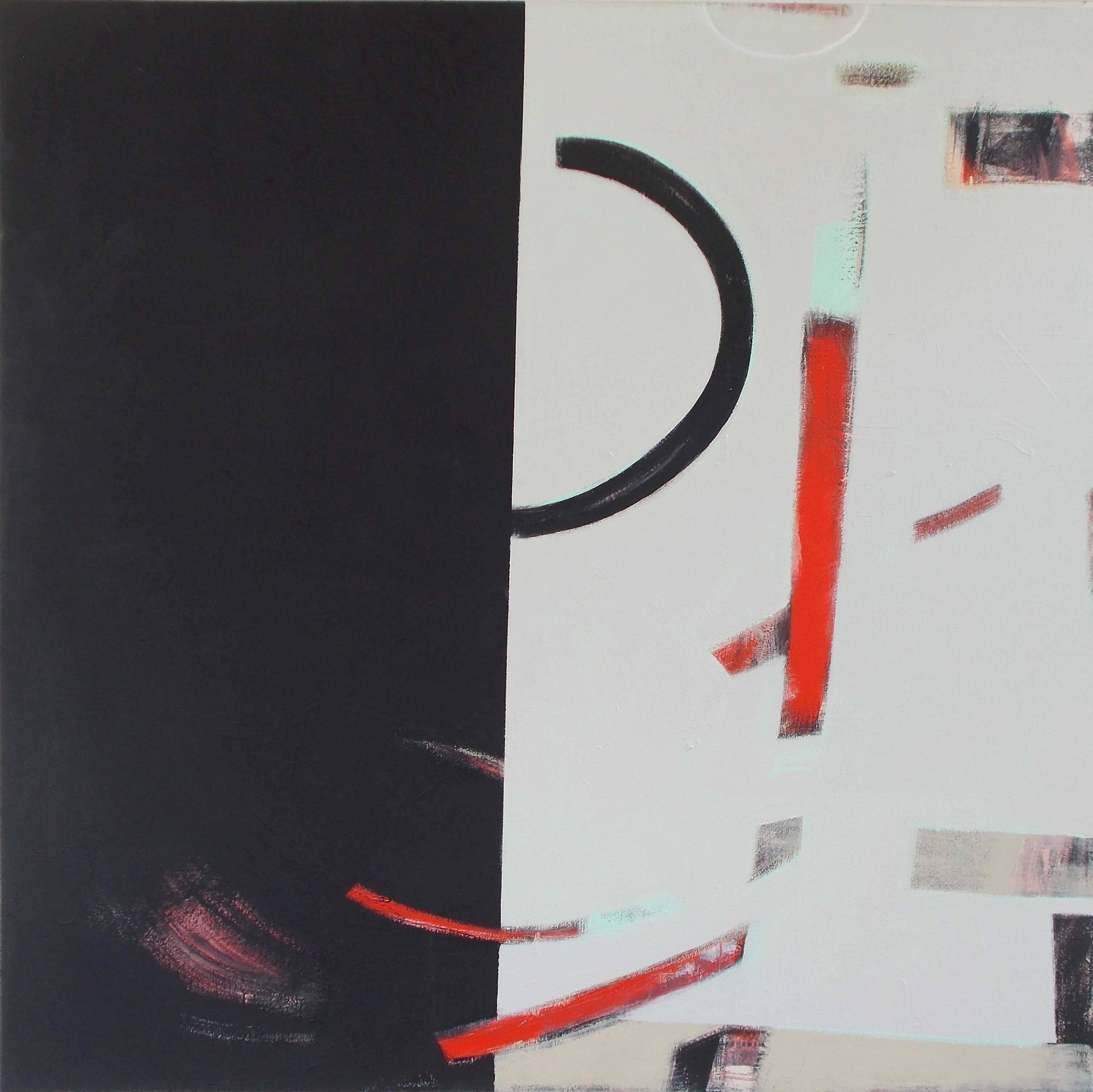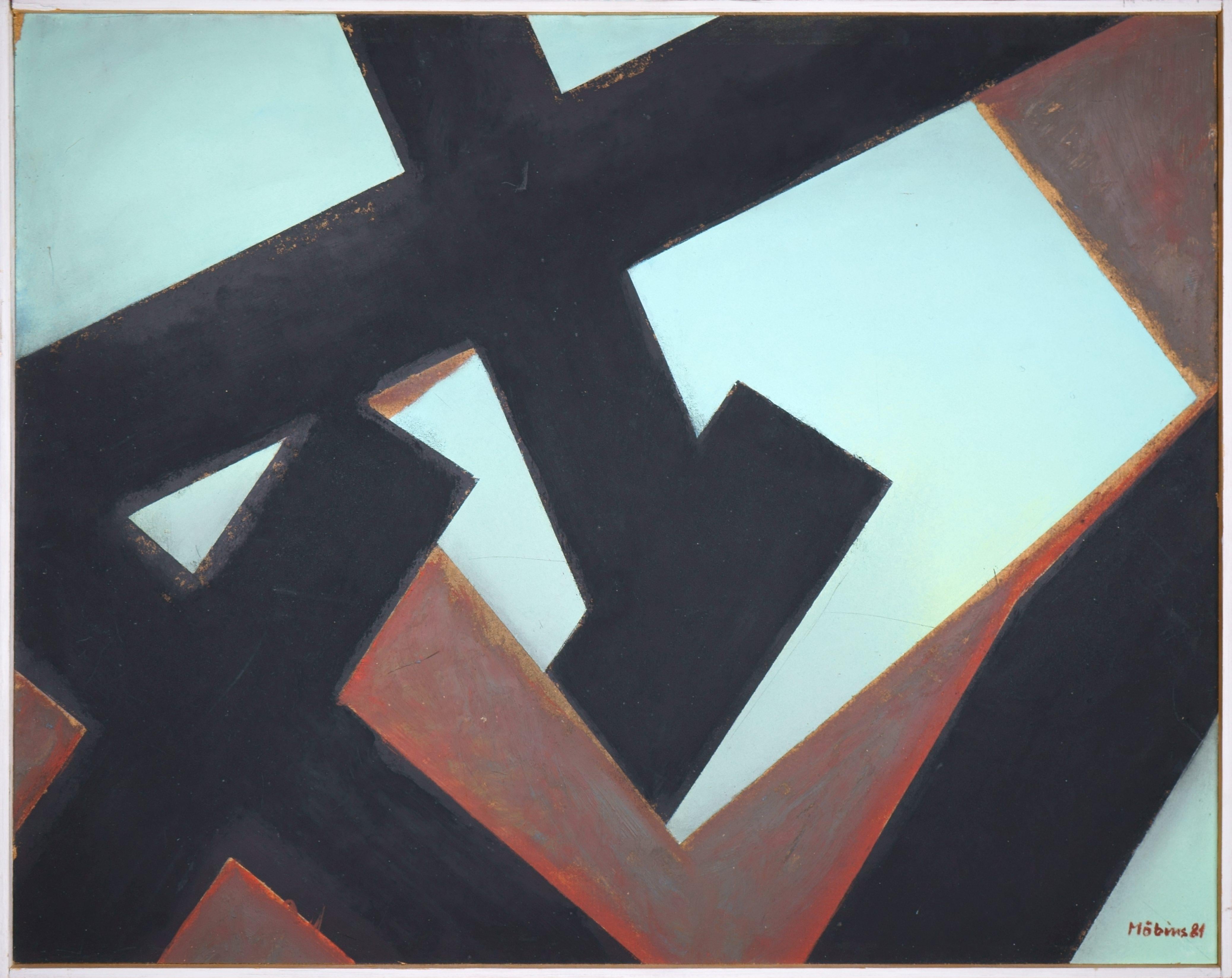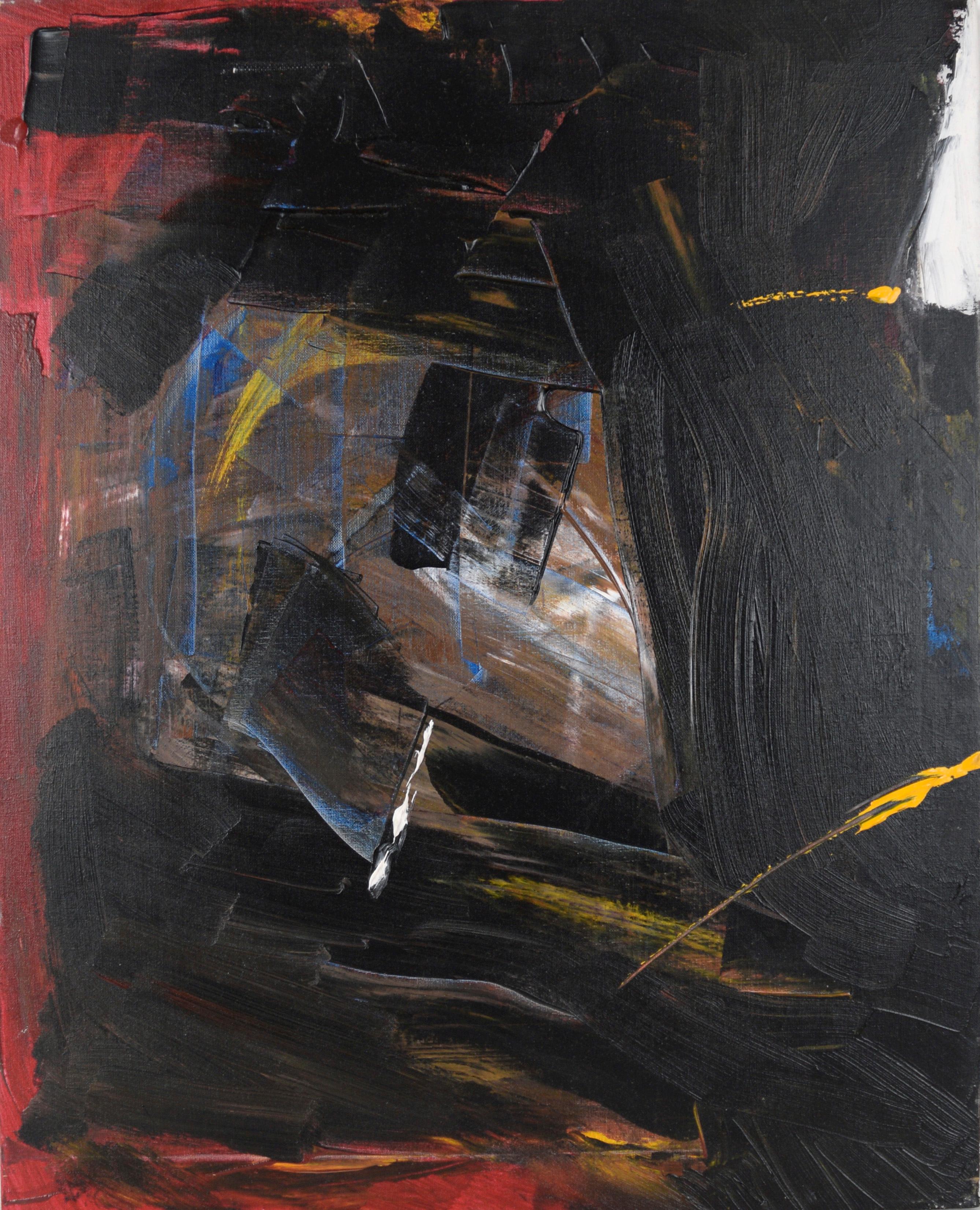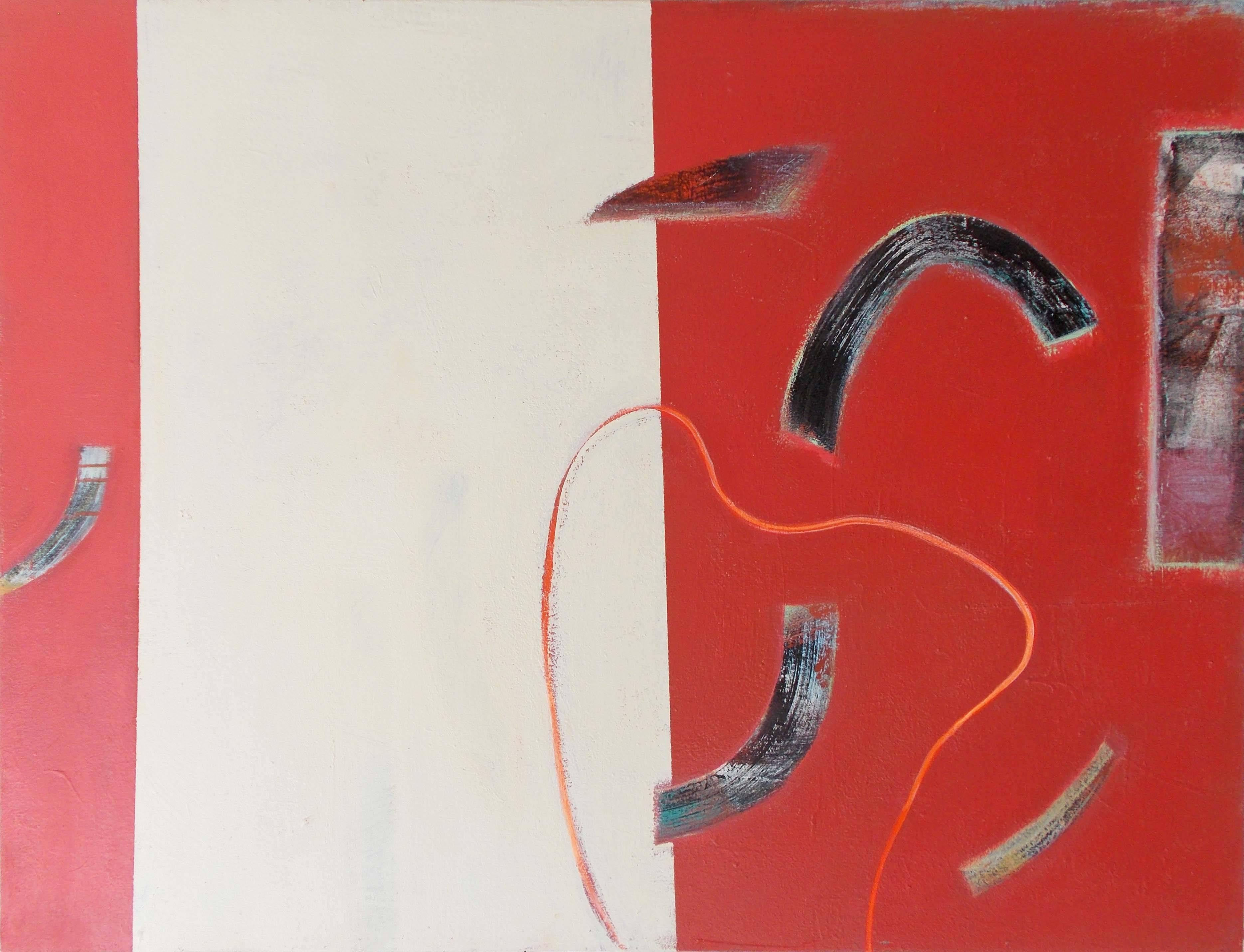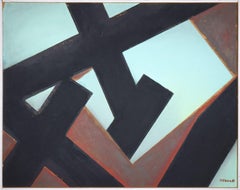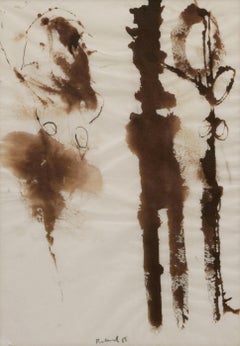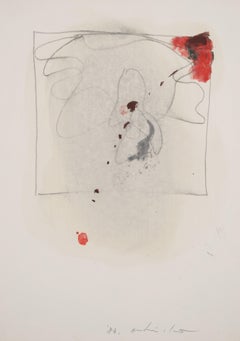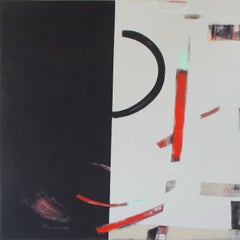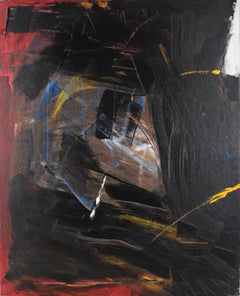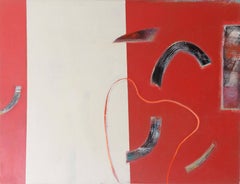Items Similar to Black form surfaces on red painterly ground / - The Double Origin of Painting -
Want more images or videos?
Request additional images or videos from the seller
1 of 8
Jürgen MöbiusBlack form surfaces on red painterly ground / - The Double Origin of Painting -1981
1981
$1,676.97
£1,254
€1,400
CA$2,310.45
A$2,519.87
CHF 1,334.86
MX$30,209.64
NOK 17,000.13
SEK 15,545.36
DKK 10,668.56
About the Item
Jürgen Möbius (*1939 Großenhain), Black form surfaces on red painterly ground. Oil on hardboard, 50 x 60 cm, 51 x 61 cm (frame), signed "Möbius" and dated "[19]81".
- Small paint chip in upper right corner, otherwise good condition. Gallery frame with slight signs of wear.
- The Double Origin of Painting -
About the artwork
In the painting black, optically dominant forms can be seen, which in their arrangement at right angles to each other have a proto-architectural character. They are, so to speak, always already given original forms. At the same time, however, the forms are surfaces of color, and thus genuine painting. In order to make the painterly character of the painting clearly visible, Jürgen Möbius has applied red-toned strokes that have preserved the brushstroke. These are traces of an act of painting.
The diagonal layers of red strokes merge into the upper white area, which oscillates between brushwork and homogeneous flatness, while the central white field, into which a black bar protrudes, has a decidedly planar character.
The sharp contrast between the autonomous black surface forms, reminiscent of Kasimir Malevich, and the free brushstroke, which is not bound to any motif, creates an enormous pictorial tension, which is conveyed by the white, but at the same time is intensified by the virulent black-and-white contrast.
In addition to the tense contrast of form and color, there is also a contrast between the dynamic of the brushstroke and the static of the black surface forms, whereby the diagonal alignment of these forms also gives the static a dynamic, while at the same time the layered brushstrokes have something static about them.
Added to this structure of tension is the fact that the painting ground, the unprepared hardboard, is clearly present as such in the picture. In this way, it becomes clear once again that we are not dealing with an autonomous cosmos of form and color, as in Suprematism, but with a painting created by the artist's hand.
With this work, Jürgen Möbius explores the possibilities of painting and thematizes painting in terms of its twofold origin, the trace of the guided brush and the painterly form, which gains its independence precisely by absorbing the brushstroke into itself.
About the artist
From 1959 to 1965 Jürgen Möbius studied painting at the University Institute for Art and Work Education in Mainz. He also studied philosophy and art history at the University of Mainz. Afterwards he worked as a freelance artist in Mainz.
At first, Möbius created material reliefs and installations, then, around 1974, he turned increasingly to conceptual art and added cinematic means. During this phase he wrote the manifesto-like essay "Principles of Supranatural Landscape" (1979).
From 1981 on, Möbius concentrated on painting and searched for artistic ways to "treat intellectual and sensual perception equally in the fusion of representational and abstract pictorial elements" (Wolfgang Zemter). He found inspiration on his study trips to Thailand and Sri Lanka.
"The pure painting of Jürgen Möbius flows through us as a timeless expression of memory and energy, ploughing our perception and bringing us the happiness of seeing authentic, immovable form.
- Philippe Büttner
Selection of solo exhibitions
1969 Galerie Würzner, Düsseldorf / Galerie Gurlitt, Mainz
1972 Städtische Galerie, Mainz
1973 Galerie Schloss Ringenberg Rathaus, Kleve
1974 Röderhausmuseum, Wuppertal
1976 Galerie Glasing, Osnabrück / Städtische Galerie, Herne
1977, 1997, 2004 Märkisches Museum, Witten
1979 Studio M, Bamberg / Staatstheater, Darmstadt
1980 Galerie Stolànovà, Wiesbaden / Mittelrheinmuseum, Koblenz
1982 Galerie Dornhöfer, Mainz
1984 Galerie Neumühle, Schlangenbad
1985 Landesmuseum, Mainz / Kunstverein, Ludwigshafen / Nassauischer Kunstverein, Wiesbaden
1986 Museum, Bochum / Galerie der Stadt Iserlohn
1987, 1990 Galerie Klaus Kiefer, Essen
1987, 2000 Galerie Ulrike Buschlinger, Wiesbaden
1988 Kunsthalle Darmstadt
1988, 1992, 1996, 1999 Galerie Leonhard, Basel
1992, 2002 Galerie Zulauf, Freisheim
1994 Galerie Remy, Vallendar
1995 Sendezentrum des Zweiten Deutschen Fernsehens, Mainz
2001 Collegium oecumenicum, Bamberg / MVB Forum für Kultur und Wirtschaft, Mainz
2006 Adam Gallery, London
Selection of group exhibitions
1969 ‘International Graphic Arts’, Galerie Dalléas Bordeaux, Paris
1975 ‘Deutscher Künstler-Bund’, Dortmund
1979 ‘Man and man’s Images’, Märkisches Museum Witten
1980 ‘Love-Dokuments of our Time’, Art Hall Darmstadt and Art Association Hannover
1982 ‘Work - Progress – Position’, Nassau Art Association Wiesbaden
1983 ‘Principle Hope – Utopic Aspects in Art and Culture of the 20th Century’, Museum Bochum
1986 ‘Selfportraits’, Gallery Klaus Kiefer Essen
1987 ‘The Dying and Death’, Gallery Klaus Kiefer Essen
1989 ‘Where are You, Revolution – Freedom, Liberty, Egality, Fraternity to-day’, Museum Bochum 1990 ‘Flight – a Problem within the Memory of Man’, Kunsthalle Darmstadt ‘Art and War 1939 – 89’, House of Cultures Berlin
1991 ‘Material and Form’, Pillnitz Castle Dresden and Pfalz Gallery Kaiserslautern
1995 20 Years Exhibitions, Chrämerhuus Langenthal, Schweiz
1998 ‘Works on Paper’, Klaus Kiefer Gallery Essen
2000 ‘Acquisitions 1900 – 2000’, Mittelrhein-Museum Koblenz
2001 ‘Strange Pictures’, Klaus Kiefer Gallery Essen
2002 ‘10 Years Buschlinger Gallery’, Buschlinger Gallery Wiesbaden
2004 ‘Eternal Space – Pictures and Sculptures’, Dome of Bamberg
2005 Art Fair Chicago, Adam Gallery, London
Selected Bibliography
Mittelrheinisches Landesmuseum (Hrsg.): Jürgen Möbius - Neue Bilder, Mainz 1985.
Kunstverein Darmstadt (Hrsg.): Jürgen Möbius. Bilder 1985 - 1988. Kunsthalle Darmstadt, 26. Juni - 14. August 1988. Red. Dorit Marhenke, Lyrik Marcus Schiltenwolf, Düsseldorf 1988.
Gabriele Prusko (Hrsg.): Jürgen Möbius. Mit Texten von Philippe Büttner und Ralph Mieritz, Basel 1992.
Wolfgang Zemter (Hrsg.): Jürgen Möbius - Aktuelle Arbeiten. Märkisches Museum der Stadt Witten, Bönen 1999.
Wolfgang Zemter (Hrsg.): Jürgen Möbius. Flieger in meinem Zimmer und Beruhigte Zone, Bönen 2004.
Dama Gallery (Hrsg.): Jürgen Möbius, London 2014.
GERMAN VERSION
Jürgen Möbius (*1939 Großenhain), Schwarze Formflächen auf rotem malerischem Grund, Öl auf Hartfaser, 50 x 60 cm, 51 x 61 cm (Rahmen), unten rechts mit „Möbius“ signiert und auf „[19]81“ datiert.
- Obere rechte Ecke mit kleinerem Farbausbruch, sonst in gutem Zustand. Galerieleiste mit leichten Gebrauchsspuren.
- Der doppelte Ursprung der Malerei -
zum Kunstwerk
Im Bild sind schwarze, optisch dominante Formen zu sehen, die in ihrer rechtwinkeligen Anordnung zueinander einen proto-architektonischen Charakter aufweisen. Es handelt sich gleichsam um immer schon gegebene Urformen. Die Formen sind jedoch zugleich Farbflächen und damit genuin Malerei. Um das Malerische des Bildes deutlich vor Augen zu stellen, hat Jürgen Möbius rottonale Striche aufgetragen, die den Pinselduktus konserviert haben. Es handelt sich um Spuren eines Malaktes.
Die diagonalen roten Strichlagen gehen in den oberen weißen Bereich über, der zwischen Pinselduktus und homogener Flächigkeit oszilliert, wobei das mittige weiße Feld, in das ein schwarzer Flächenbalken hineinragt, einen dezidierten Flächencharakter aufweist.
Der scharfe Kontrast zwischen den an Kasimir Malewitsch gemahnenden autonomen schwarzen Flächenformen und dem freien, an kein Motiv zurückgebundenen Pinselduktus erzeugt eine enorme Bildspannung, die zwar vom Weiß vermittelt wird, durch den dabei virulenten Schwarz-Weiß-Kontrast zugleich aber auch eine weitere Intensivierung erfährt.
Neben dem spannungsvollen Kontrast der Form und der Farbe besteht zudem ein Kontrast zwischen der Dynamik des Pinselstrichs und der Statik der schwarzen Flächenformen, wobei durch die diagonale Ausrichtung dieser Formen auch das Statische eine Dynamik aufweist, während die übereinander geschichteten Pinselstriche zugleich etwas Statisches haben.
Zu diesem Spannungsgefüge kommt hinzu, dass der Malgrund, die nicht präparierte Hartfaserplatte, deutlich als solche im Bild präsent ist. Auf diese Weise wird abermals sichtbar, dass es sich nicht um einen autonomen Form- und Farbkosmos handelt, wie dies im Suprematismus der Fall ist, sondern um ein von Künstlerhand geschaffenes Gemälde.
Mit diesem spannungsvollen Werk lotet Jürgen Möbius den Möglichkeitsraum der Malerei aus und thematisiert die Malerei auf ihren zweifachen Ursprung hin, der Spur des geführten Pinsels und der malerisch hervorgebrachten Form, die gerade dadurch ihre Eigenständigkeit gewinnt, indem sie den Pinselduktus in sich absorbiert.
zum Künstler
Von 1959 bis 1965 studierte Jürgen Möbius Malerei am Mainzer Hochschulinstitut für Kunst- und Werkerziehung. Zudem absolvierte er ein Studium der Philosophie und Kunstgeschichte an der Universität Mainz. Anschließend war er in Mainz als freischaffender Künstler tätig.
Zunächst schuf Möbius Materialreliefs und Installationen, um sich dann, gegen 1974, verstärkt der Konzeptkunst zuzuwenden und filmische Mittel hinzuzuziehen. In dieser Phase verfasste er den manifestartigen Essay „Prinzipien der supranaturalen Landschaft" (1979).
Ab 1981 konzentriert sich Möbius auf die Malerei und sucht nach künstlerischen Wegen, in der „Verschmelzung von gegenständlichen und abstrakten Bildelementen, die intellektuelle und sinnliche Wahrnehmung als gleichwertig [zu] behandeln“ (Wolfgang Zemter). Inspirationen dazu gewinnt er auf seinen Studienreisen, die nach Thailand und Sri Lanka führen.
„[Die reine Malerei von Jürgen Möbius] flutet als zeitloser Ausdruck von Erinnerung und Energie durch uns hindurch, pflügt unsere Wahrnehmung und bringt uns das Glück des Sehens authentischer, unverrückbarer Form.“
- Philippe Büttner
Auswahl an Einzelausstellungen
1969 Galerie Würzner, Düsseldorf / Galerie Gurlitt, Mainz
1972 Städtische Galerie, Mainz
1973 Galerie Schloss Ringenberg Rathaus, Kleve
1974 Röderhausmuseum, Wuppertal
1976 Galerie Glasing, Osnabrück / Städtische Galerie, Herne
1977, 1997, 2004 Märkisches Museum, Witten
1979 Studio M, Bamberg / Staatstheater, Darmstadt
1980 Galerie Stolànovà, Wiesbaden / Mittelrheinmuseum, Koblenz
1982 Galerie Dornhöfer, Mainz
1984 Galerie Neumühle, Schlangenbad
1985 Landesmuseum, Mainz / Kunstverein, Ludwigshafen / Nassauischer Kunstverein, Wiesbaden
1986 Museum, Bochum / Galerie der Stadt Iserlohn
1987, 1990 Galerie Klaus Kiefer, Essen
1987, 2000 Galerie Ulrike Buschlinger, Wiesbaden
1988 Kunsthalle Darmstadt
1988, 1992, 1996, 1999 Galerie Leonhard, Basel
1992, 2002 Galerie Zulauf, Freisheim
1994 Galerie Remy, Vallendar
1995 Sendezentrum des Zweiten Deutschen Fernsehens, Mainz
2001 Collegium oecumenicum, Bamberg / MVB Forum für Kultur und Wirtschaft, Mainz
2006 Adam Gallery, London
Auswahl an Gruppenausstellungen
1969 ‘International Graphic Arts’, Galerie Dalléas Bordeaux, Paris
1975 ‘Deutscher Künstler-Bund’, Dortmund
1979 ‘Man and man’s Images’, Märkisches Museum Witten
1980 ‘Love-Dokuments of our Time’, Art Hall Darmstadt and Art Association Hannover
1982 ‘Work - Progress – Position’, Nassau Art Association Wiesbaden
1983 ‘Principle Hope – Utopic Aspects in Art and Culture of the 20th Century’, Museum Bochum
1986 ‘Selfportraits’, Gallery Klaus Kiefer Essen
1987 ‘The Dying and Death’, Gallery Klaus Kiefer Essen
1989 ‘Where are You, Revolution – Freedom, Liberty, Egality, Fraternity to-day’, Museum Bochum 1990 ‘Flight – a Problem within the Memory of Man’, Kunsthalle Darmstadt ‘Art and War 1939 – 89’, House of Cultures Berlin
1991 ‘Material and Form’, Pillnitz Castle Dresden and Pfalz Gallery Kaiserslautern
1995 20 Years Exhibitions, Chrämerhuus Langenthal, Schweiz
1998 ‘Works on Paper’, Klaus Kiefer Gallery Essen
2000 ‘Acquisitions 1900 – 2000’, Mittelrhein-Museum Koblenz
2001 ‘Strange Pictures’, Klaus Kiefer Gallery Essen
2002 ‘10 Years Buschlinger Gallery’, Buschlinger Gallery Wiesbaden
2004 ‘Eternal Space – Pictures and Sculptures’, Dome of Bamberg
2005 Art Fair Chicago, Adam Gallery, London
Auswahlbibliographie
Mittelrheinisches Landesmuseum (Hrsg.): Jürgen Möbius - Neue Bilder, Mainz 1985.
Kunstverein Darmstadt (Hrsg.): Jürgen Möbius. Bilder 1985 - 1988. Kunsthalle Darmstadt, 26. Juni - 14. August 1988. Red. Dorit Marhenke, Lyrik Marcus Schiltenwolf, Düsseldorf 1988.
Gabriele Prusko (Hrsg.): Jürgen Möbius. Mit Texten von Philippe Büttner und Ralph Mieritz, Basel 1992.
Wolfgang Zemter (Hrsg.): Jürgen Möbius - Aktuelle Arbeiten. Märkisches Museum der Stadt Witten, Bönen 1999.
Wolfgang Zemter (Hrsg.): Jürgen Möbius. Flieger in meinem Zimmer und Beruhigte Zone, Bönen 2004.
Dama Gallery (Hrsg.): Jürgen Möbius, London 2014.

About the Seller
5.0
Vetted Professional Seller
Every seller passes strict standards for authenticity and reliability
Established in 2014
1stDibs seller since 2023
23 sales on 1stDibs
- ShippingRetrieving quote...Shipping from: Berlin, Germany
- Return Policy
More From This Seller
View AllTectonic Tension / - Archetypes of Painting -
Located in Berlin, DE
Jürgen Möbius (*1939 Großenhain), Tectonic Tension. Oil on hardboard, 47.5 x 60 cm, 49 x 61.5 cm (frame), signed lower right "Möbius" and dated "[19]81".
- Upper left corner with a small chip, light scratches and a little rubbed in places. Provisional gallery frame with traces of use.
- Archetypes of Painting -
About the artwork
The form structure in front of the eye is overlapped by the frame. Thus, the frame does not open up a space in which something is presented, but rather shows the seemingly arbitrary section of a comprehensive context that cannot be framed as such.
We see forms that stand in a structure of tension with each other, whereby the individual black and brown forms, which continue almost endlessly beyond the frame, already show a tension in themselves, since they are not only forms, but also surfaces - form surfaces, while the light blue surface ground is at the same time forms that appear as surface forms. The formed surfaces and surface forms are nested within each other and form a structure that encompasses all elements.
The angular arrangement of the black and brown shaped surfaces gives the structure a tectonic character. The tension is thus heightened to the point of paradox, since the black shape at the front is overlapped by the brown shape at the bottom in the center of the picture, which would be impossible in real space. It is precisely through this "paradox" that Möbius demonstrates that the paradoxical is reality within painting. It is, so to speak, the most original possibility of painting, which distinguishes it from the other arts. In combination with the tectonic formations, Jürgen Möbius creates an archaic primordial painting, which, however, should not be confused with the autonomous color and form cosmos of Suprematism à la Kasimir Malevich. Instead of homogeneous, perfectly colored forms, here the colors are deliberately applied unevenly, and the light blue is mixed with the brown in a manner determined by the brushstroke. At the edges of the surface forms, the uneven application of paint allows the wood of the unprimed hardboard to show through. In this way, Möbius illustrates that we are dealing with a painting that has been created by an act of painting - an act, however, that takes hold of the original principles of painting and thus realizes painting as such.
About the artist
From 1959 to 1965 Jürgen Möbius studied painting at the University Institute for Art and Work Education in Mainz. He also studied philosophy and art history at the University of Mainz. Afterwards he worked as a freelance artist in Mainz.
At first, Möbius created material reliefs and installations, then, around 1974, he turned increasingly to conceptual art and added cinematic means. During this phase he wrote the manifesto-like essay "Principles of Supranatural Landscape" (1979).
From 1981 on, Möbius concentrated on painting and searched for artistic ways to "treat intellectual and sensual perception equally in the fusion of representational and abstract pictorial elements" (Wolfgang Zemter). He found inspiration on his study trips to Thailand and Sri Lanka.
"The pure painting of Jürgen Möbius flows through us as a timeless expression of memory and energy, ploughing our perception and bringing us the happiness of seeing authentic, immovable form.
- Philippe Büttner
Selection of solo exhibitions
1969 Galerie Würzner, Düsseldorf / Galerie Gurlitt, Mainz
1972 Städtische Galerie, Mainz
1973 Galerie Schloss Ringenberg Rathaus, Kleve
1974 Röderhausmuseum, Wuppertal
1976 Galerie Glasing, Osnabrück / Städtische Galerie, Herne
1977, 1997, 2004 Märkisches Museum, Witten
1979 Studio M, Bamberg / Staatstheater, Darmstadt
1980 Galerie Stolànovà, Wiesbaden / Mittelrheinmuseum, Koblenz
1982 Galerie Dornhöfer, Mainz
1984 Galerie Neumühle, Schlangenbad
1985 Landesmuseum, Mainz / Kunstverein, Ludwigshafen / Nassauischer Kunstverein, Wiesbaden
1986 Museum, Bochum / Galerie der Stadt Iserlohn
1987, 1990 Galerie Klaus Kiefer, Essen
1987, 2000 Galerie Ulrike Buschlinger, Wiesbaden
1988 Kunsthalle Darmstadt
1988, 1992, 1996, 1999 Galerie Leonhard, Basel
1992, 2002 Galerie Zulauf, Freisheim
1994 Galerie Remy, Vallendar
1995 Sendezentrum des Zweiten Deutschen Fernsehens, Mainz
2001 Collegium oecumenicum, Bamberg / MVB Forum für Kultur und Wirtschaft, Mainz
2006 Adam Gallery, London
Selection of group exhibitions
1969 ‘International Graphic Arts’, Galerie Dalléas Bordeaux, Paris
1975 ‘Deutscher Künstler-Bund’, Dortmund
1979 ‘Man and man’s Images’, Märkisches Museum Witten
1980 ‘Love-Dokuments of our Time’, Art Hall Darmstadt and Art Association Hannover
1982 ‘Work - Progress – Position’, Nassau Art Association Wiesbaden
1983 ‘Principle Hope – Utopic Aspects in Art and Culture of the 20th Century’, Museum Bochum
1986 ‘Selfportraits’, Gallery Klaus Kiefer Essen
1987 ‘The Dying and Death’, Gallery Klaus Kiefer Essen
1989 ‘Where are You, Revolution – Freedom, Liberty, Egality, Fraternity to-day’, Museum Bochum 1990 ‘Flight – a Problem within the Memory of Man’, Kunsthalle Darmstadt ‘Art and War 1939 – 89’, House of Cultures Berlin
1991 ‘Material and Form’, Pillnitz Castle Dresden and Pfalz Gallery Kaiserslautern
1995 20 Years Exhibitions, Chrämerhuus Langenthal, Schweiz
1998 ‘Works on Paper’, Klaus Kiefer Gallery Essen
2000 ‘Acquisitions 1900 – 2000’, Mittelrhein-Museum Koblenz
2001 ‘Strange Pictures’, Klaus Kiefer Gallery Essen
2002 ‘10 Years Buschlinger Gallery’, Buschlinger Gallery Wiesbaden
2004 ‘Eternal Space – Pictures and Sculptures’, Dome of Bamberg
2005 Art Fair Chicago, Adam Gallery, London
Selected Bibliography
Mittelrheinisches Landesmuseum (Hrsg.): Jürgen Möbius - Neue Bilder, Mainz 1985.
Kunstverein Darmstadt (Hrsg.): Jürgen Möbius. Bilder 1985 - 1988. Kunsthalle Darmstadt, 26. Juni - 14. August 1988. Red. Dorit Marhenke, Lyrik Marcus Schiltenwolf, Düsseldorf 1988.
Gabriele Prusko (Hrsg.): Jürgen Möbius. Mit Texten von Philippe Büttner und Ralph Mieritz, Basel 1992.
Wolfgang Zemter (Hrsg.): Jürgen Möbius - Aktuelle Arbeiten. Märkisches Museum der Stadt Witten, Bönen 1999.
Wolfgang Zemter (Hrsg.): Jürgen Möbius. Flieger in meinem Zimmer und Beruhigte Zone, Bönen 2004.
Dama Gallery...
Category
1980s Abstract Abstract Paintings
Materials
Oil
Untitled / - Association -
Located in Berlin, DE
Detlef Baltrock (*1954 Stuttgart), Untitled, 1985. Watercolor, 29.5 cm x 21 cm (visible dimensions), 41 cm x 32 cm (frame), signed “Baltrock” lower center and signed “[19]85”, label ...
Category
1980s Abstract Expressionist Abstract Drawings and Watercolors
Materials
Paper
Untitled / - Bleeding Picture -
Located in Berlin, DE
Ouhi Cha (*1945 Busan), Untitled, 1988. mixed media, 31.8 cm x 23.3 cm (sheet size), signed “Ouhi Cha” in pencil below and dated “[19]88”.
- in good condition
- Bleeding Picture -...
Category
1980s Abstract Abstract Drawings and Watercolors
Materials
Paper
Untitled / - The archaism of nature -
Located in Berlin, DE
Jorge Machold (1940 Chemnitz - 2015 Berlin), Untitled, 1973. Color etching, 41.5 x 29.2 cm (plate size), 49.5 cm x 39.5 cm (sheet size), signed lower right in lead “J.[orge] Machold”...
Category
1970s Abstract Abstract Prints
Materials
Paper
My treasure, my sanctuary / - A Tortured Treasure -
Located in Berlin, DE
Johannes Heisig (*1953 Leipzig), "My treasure, my sanctuary" - To the Christmas Oratorio by Johann Sebastian Bach. Lithograph on strong yellowish laid paper with watermark, 53 x 39.5...
Category
1980s Abstract Expressionist Figurative Prints
Materials
Lithograph
$364 Sale Price
20% Off
Eccentric discharges of a blue-red core / - Energetic traces -
Located in Berlin, DE
Klaus Oldenburg (*1942 Berlin), Eccentric discharges of a blue-red core, around 1975. paint and cast resin on chipboard, 39 x 59 cm (inside dimension),...
Category
1970s Abstract Abstract Paintings
Materials
Resin
You May Also Like
Large Abstract Black and Red Original Abstract Painting Dichotomy Michael Moon
By Michael Moon
Located in Miami, FL
A very sophisticated contemporary abstract work by this well known California artist is a good example of emotive abstract painting. Divided by white and black, this painting swirls...
Category
2010s Abstract Abstract Paintings
Materials
Cotton Canvas, Acrylic
$5,720 Sale Price
35% Off
Feminine Red And Black Modern Abstract Structured Painting By Sture Wikström
Located in Frederiksberg C, DK
Presenting a modern abstract composition with a textured impasto surface created by the Swedish artist, Sture Wikström (1921-1993). With its textured su...
Category
Late 20th Century Abstract Abstract Paintings
Materials
Acrylic, Board
Vintage Abstract Expressionist Painting - Red and Black Strokes on Canvas
Located in Soquel, CA
Vintage Abstract Expressionist Painting - Red and Black Strokes on Canvas
Intriguing and moody piece by California-based Latin-American artist, Ricardo de Silva (American/Brazil, 20...
Category
1980s Abstract Expressionist Abstract Paintings
Materials
Canvas, Acrylic
Red and Black Original Canvas Abstract Painting Pathways # 20
By Michael Moon
Located in Miami, FL
An abstract original painting by this well known California artist, is a vibrant yet soothing work beautifully painted. The vibrant reds and the black accents move around the canvas...
Category
2010s Abstract Abstract Paintings
Materials
Acrylic, Cotton Canvas
$2,880 Sale Price
40% Off
Abstraction in Black and Red - Original Oil on Canvas, Signed
Located in Paris, IDF
Jan MEIJER (Jan MEYER, called)
Abstraction in Black and Red, 1970
Original Oil on Canvas
Signed in the lower left corner
Signed, dated on the back
On canvas 81 x 54 cm (c. 32 x 22 i...
Category
1970s Abstract Abstract Paintings
Materials
Oil
Bold Modern Abstract Art: Striking Red Canvas with Black Gestural Strokes
By Jean Soyer
Located in Clermont-Ferrand, Auvergne-Rhône-Alpes
A striking abstract oil painting on canvas (32 x 26 inches) by Jean Soyer, featuring dramatic interplay between vibrant red and deep black. The composition showcases bold, dynamic br...
Category
21st Century and Contemporary Abstract Abstract Paintings
Materials
Canvas, Oil
More Ways To Browse
Dior 1987
Sunflower Abstract
Abstract Sailboat
Airbrush Art
Architectural Blueprints
Large Horizontal Painting
Maroon Art
Paper Airplane
Psychedelic Painting
Sergei Chernyakovsky
Dia De Muertos
Galaxy Painting
Jack Shadbolt
Marfa Texas
Mexico San Miguel
Mid Century Modern Austin Texas
Oil Stick Painting
1950s Abstract Oil Paintings
